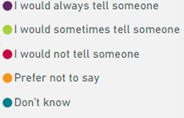By Mariana Meneses
Digital media use has become an inseparable part of modern childhood, offering both opportunities and challenges.
While it provides valuable tools for education and socialization, it also exposes children to risks like social media dependency, gaming addiction, and mental health issues.
The issues have recently come to the forefront with the Australian Government’s recent restriction of social media access to those under 16 and the World Health Organization’s call for improved digital literacy and greater platform accountability. This article explores these pressing concerns, and examines global efforts to help young people navigate the digital world safely.
The World Health Organization’s Regional Office for Europe reports a concerning rise in excessive social media and gaming use among adolescents, with 11% showing signs of social media dependency—marked by struggles to control use and negative daily consequences—and 12% at risk of harmful gaming behaviors.
Although digital technologies offer educational opportunities, according to the WHO report, these habits are linked to poorer mental health, including depression, anxiety, reduced sleep, and lower life satisfaction. Across the 38 member countries of the OECD, 59% of students reported being distracted in math lessons by peers’ device use, leading to lower test scores. Even in schools with smartphone bans, 29% of students used phones several times daily.
The OECD also warns of risks like cyberbullying, privacy breaches, and exposure to harmful content, alongside concerns about anxiety, poor sleep, and distorted body image. The WHO calls for urgent action, including improved digital literacy education and platform accountability to create safer online environments for youth.
Overview of digital use among youth
In the Survey on Information and Communication Technology Usage by Children, 2024, by the Turkish Statistical Institute, it was found that 91.3% of children aged 6-15 used the internet, with 97.4% reporting regular use, primarily for watching videos (83.9%), learning (75%), and gaming (72.7%). Social media usage reached 72.6%, led by YouTube, while Instagram dominated among older children. Mobile phone usage rose to 76.1%, primarily for Internet browsing and social media, with 32.6% of users checking their phones every 30 minutes. Digital gaming was more common among boys (82.8% vs. 64.8% for girls), with 40.1% of regular players exceeding planned gaming time. Screen time impacted habits, as 34.4% reported reading less and 33.3% studied less.
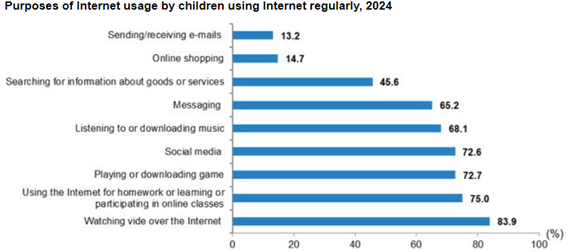
84% of children used the interned to watch videos. Image: Survey on Information and Communication Technology Usage by Children, 2024 (Turkish Statistical Institute).
The UK government asked children and parents questions about their media use, attitudes, and understanding, as well as how parents monitor and manage their children’s media consumption.
Here are just a few of their findings from the Children and parents: media use and attitudes report 2024:
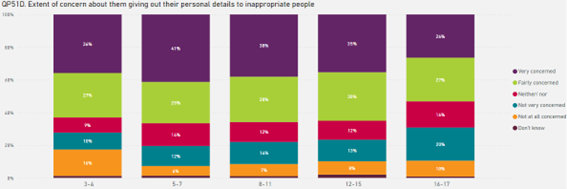
Over 40% of parents of children aged 5-7 are very concerned about them giving out personal details online.
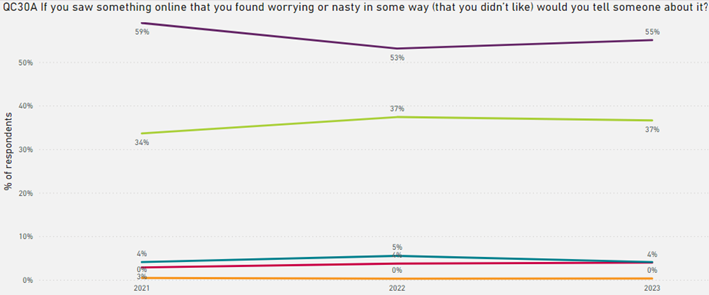
37% of children said they would ‘sometimes’ tell someone if they saw something worrying or nasty online.
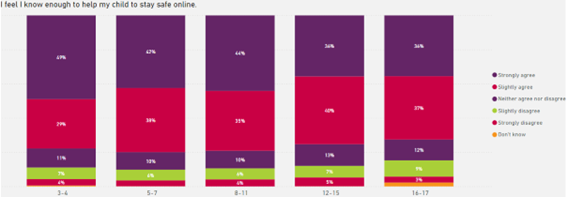
Over 70% of parents feel in some degree that they do not know enough to help their child to stay safe online.
In the US, the Pew Research Center showed in 2020 that a significant portion of parents (39%) worried about data collection by voice-activated assistants like Siri or Alexa, with 11% very concerned.
Regarding social media, most parents of children under 12 reported that their kids were not using these platforms, but concerns grew with age. Among children aged 9-11, 30% used TikTok and 10% used Snapchat. Parents of children with phones were more likely to report social media use. Additionally, parents with lower educational levels tended to express more concern about their children’s online activity, including social media use.
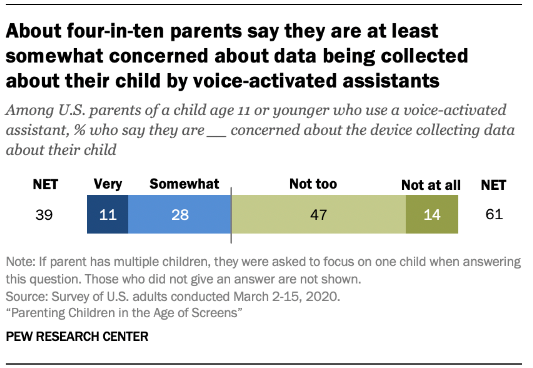
In 2020, about 40% of parents were concerned about data privacy with children’s use of voice-activated assistants such as Alexa and Siri. The Pew Research Center.
The U.S. National Institute of Child Health and Human Development (NICHD) highlights several risks associated with children’s exposure to digital media.
They report on studies that have shown that high screen time in toddlers under 2 years is linked to atypical sensory processing, and that playing video games and watching videos can trigger the onset of obsessive-compulsive disorder. Additionally, the NICHD emphasizes the growing issue of online harassment and abuse, prompting collaborative efforts.
“Dry eye is one example of a health issue that we’re seeing clinically that is associated with frequent and extended use of screen-based digital technologies and young people. But frequent screen use is a risk factor for numerous areas of children’s health.” — Julie Cullen, a paediatric physiotherapist and founder of Sensible Screen use.
Children’s Screen Time & Use of Digital Technology in Early Childhood Education Recommendations
What can be done?
A 2024 study led by Jennifer Meier, a PhD student at the University of Cologne, in Germany, examined how schoolchildren use digital media both in and outside of school.
Over six weeks, 84 German schoolchildren aged 10-16 participated, using media diaries to track their media habits. The study found that children expressed higher importance and satisfaction with their digital media usage outside of school, and although they reported high self-confidence in most digital skills, they rated below average in algorithms and programming. The reported learning gains in digital media usage were consistently low, with no significant change in usage patterns over the study period. The study encourages rethinking how digital media are integrated into classrooms to enhance educational outcomes.
The United Nations’ UNICEF emphasizes the need for the European Union to enhance and enforce legislation that safeguards children from both established and emerging online risks, particularly in the context of digital violence and exploitation.
The organization advocates for a comprehensive legislative framework to combat online abuse, the alignment of national laws with international human rights standards, and increased investment in law enforcement and social services to support victims. Additionally, UNICEF calls for the assessment and monitoring of AI policies impacting children, a balanced approach to risk management, and the full implementation of the Better Internet for Kids (BIK+) strategy to address the digital divide and promote digital empowerment among all children.
A 2024 report led by Mattia Messena, from the University College Dublin School of Medicine, found that pre-adolescent children aged 10 and 11 with stronger digital skills experienced greater well-being compared to their peers with lower digital proficiency.
Conducted with 700 children from Ireland and Italy, the study highlighted the importance of teaching digital literacy to help children navigate online risks while taking advantage of digital opportunities. Irish children demonstrated higher digital skills and greater access to technology than their Italian counterparts, with tablets being the most used device in both countries. The research, carried out in Spring 2022, reflects the post-pandemic shift in children’s use of technology.
Personal Data Protection Commission, Singapore, Advisory Guidelines for Children’s Personal Data in the Digital Environment, 2024, emphasize the necessity of using age-appropriate language and media to communicate with children, ensuring that they understand the implications of sharing their data.
Additionally, they highlight the importance of implementing robust security practices, including disabling geolocation features by default and collecting only the minimum necessary data. In the event of a data breach, organizations are required to have processes in place to promptly notify both the child and their parents or guardians, ensuring that the communication is clear and comprehensible.
UNESCO’s Guidelines for parents and educators on child online protection, 2020, highlight the significant rise in children’s online engagement that accelerated during the COVID-19 pandemic, exposing them to various risks, including exposure to inappropriate content and cyberbullying. The guidelines stress the necessity for parents and educators to foster open communication with children about their online experiences, encouraging them to express concerns and seek guidance. Additionally, they emphasize the importance of digital literacy, urging adults to help children develop critical information-seeking skills to navigate the vast amount of content available online, including the challenges posed by misinformation and fake news.
The Australian Government’s Guide to cyber security for parents and carers, 2024, advises families to improve online security, with the following first steps:
- Set up parental controls on devices to manage access to inappropriate content,
- Educate children about online safety, including risks like cyberbullying and identity theft,
- Use strong and unique passwords for online accounts and consider using a reputable password manager,
- Enable multi-factor authentication (MFA) to add an extra layer of security,
- Keep software up to date to address security vulnerabilities,
- Install antivirus software to protect against malware and other threats,
- Back up important data regularly to prevent loss,
- Be cautious of online scams, including unsolicited emails, texts, or phone calls that ask for personal or financial information, and teach children to recognize them,
- Monitor children’s online activities to stay informed about their interactions,
- Teach children how to report inappropriate behaviour or cyberbullying, and
- Stay informed about the latest cybersecurity trends and threats, such as by checking platforms like Scamwatch, or using resources like ThinkUKnow.
While digital technologies offer valuable opportunities for learning and development, the risks associated with excessive screen time and online safety concerns highlight the need for action.
Governments, organizations, and parents can collaborate to implement effective digital literacy programs, strengthen safeguards against online harm, and ensure that children can navigate the digital world safely, by staying informed and embracing cybersecurity measures, such as parental controls and multi-factor authentication. By taking action, we can help children thrive in a digital society.
Craving more information? Check out these recommended TQR articles:
- Legal Perils and Protections for Online Consumers are Rapidly Evolving
- The Fascinating History of the Computer, from ENIAC, Vacuum Tubes and Transistors, to Microchips
- Emerging Issues in Space Governance Urgently Require International Agreement
- A Five-Year-Old’s Challenge to Free-Speech Absolutism
- The Real and Present Dangers of Reducing Four-Dimensional Living to Two-Dimensional Screen Projections
- AI in Classrooms: Enhancing Education or Replacing Teachers?
- Update on Global AI Regulations: With Great Power Comes Great Responsibility
Your feedback helps us shape The Quantum Record just for you. Share your thoughts in our quick, 2-minute survey!
☞ Click here to complete our 2-minute survey



